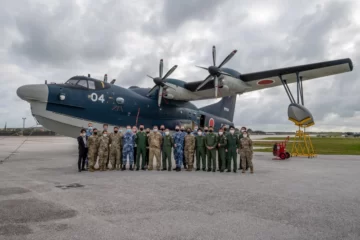SOFIC 2022 took place in Tampa, Florida, 16-19 May and was presented by a panel of speakers lead by Colonel Kenneth Kuebler, USAF, Director of the Air Force Portfolio Division. Naval News readers can look here for more information on USSOCOM’s pursuit for an amphibious C-130 seaplane.

Rich Rodriguez, USSOCOM’s Tech Director in Emerging Technologies, offered new details at SOFIC 2022 as to the progress and goal of the Amphibious MC-130 (MAC) demonstration:
“In terms of amphibious MC-130 demonstration, USSOCOM is actually going through some market research, currently, to see if we can identify any potential amphibious capacities to meet some of the SOF Requirements that are existing. And currently AFSOC is also doing an experimental demonstration where they are planning on putting some float assemblies on a C-130 platform. They use digital engineering as a major factor of reducing some of that risk and making some of those changes, and they have gone through some hydrotesting and some aero testing on a subscale factor.”
Naval News Comments and Author’s Comments
For speculative discussion purposes, Colonel Kuebler said that USSOCOM is looking at these areas to modernize: Autonomation—the ability to have an Operator control more than one item with the goal of reducing crew workload and instead having the Operator focus on critical items such as safety or combat-critical areas; Survivability—adding defensive systems for “Greater stand-off” from a permissive environment [counterterrorism] to survive in a contested environment [against peer nations]. Colonel Kuebler describes this setup as similar to LEGO building blocks for a “truly multi-mode modular system that I [USSOCOM] can easily and quickly put on whatever payload that field commander needs for that mission.”
How these SOCOM modernization areas affect the MC-130 amphibious demonstration is unclear, but Mr. Rodriguez’s SOFIC 2022 comment did give an indication that USSOCOM may be looking for any seaplane candidates that fit the need for amphibious military cargo lift (such as the DARPA “Liberty Lifter” or the Japanese ShinMaywa US-2). The U.S. Air Force Special Operations Command (AFSOC) on the other hand is looking at adding pontoon floats to an existing C-130 and not modifying it extensively with a seaplane boat hull, which was an early concept by Lockheed Martin dating back several years.


Also unclear is how USSOCOM will load and unload cargo from a MC-130J’s fuselage resting high up on floating pontoons as the rear cargo ramp might be so high that the steep angle of the rear ramp might prevent true drive-on/drive-off of watercraft and boats such as RHIBs, jetskis, amphibious vehicles, and Combat Rubber Raiding Crafts (CRRCs). The U.S. Army’s secretive and elite Task Force-160’s MH-47s often sit in the water and deploy their rear cargo ramps for rapid CRRC exfiltration and infiltration where the CRRC can literally drive right up and into the flooded interior of the MH-47. However, the amphibious MC-130J will be sitting on pontoons so this “wet duck CRRC extraction” method might not be feasible if the pontoons cannot ballast to lower the C-130’s fuselage and ramp closer to the water’s surface, or if the MC-130J’s interior is allowed to be floodable.

Apparently, AFSOC is aware of the height of the pontoons resting on water as a graphic shows ladders and steps leading to the pontoons, although if the floating pontoons can be ballasted and submerged is unclear. Note that the MC-130J’s Forward Looking Infrared (FLIR) turret ball rests underneath the nose of the plane (would that be submerged if the pontoons can be ballasted down, and if so, is the FLIR ball waterproof and can its delicate electronics stand the pounding waves?). Furthermore, factoring in sea spray, surf, and waves may have detrimental effects on the MC-130J’s navigation, nose radar, antennas, sensors, and delicate electronics if the fuselage rests so close or is in the water without a seaplane belly design like the Japanese ShinMaywa US-2.

U.S. Navy Commander Tim Hawkins, former USSOCOM spokesperson, said it aptly to Naval News on May 2021 (bold emphasis added):
“MC-130J Amphibious Capability, or “MAC” as we call it, is a concept we are exploring. The MAC concept involves being able to modify the aircraft and give it the capability to take off and land both on the ground and water – all in the same mission. This is a challenging physics and engineering proposition, so SOCOM is currently working with industry on feasibility and operational studies as well as digital designs in order to determine the best path forward on capability development.”






